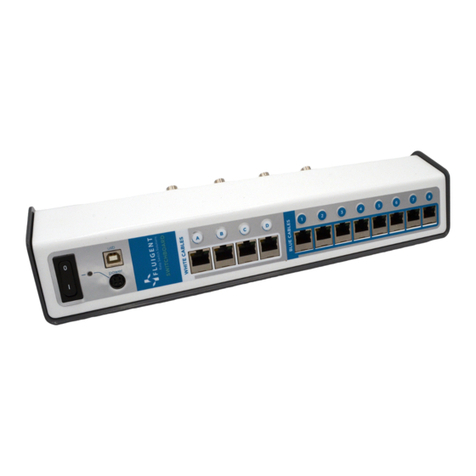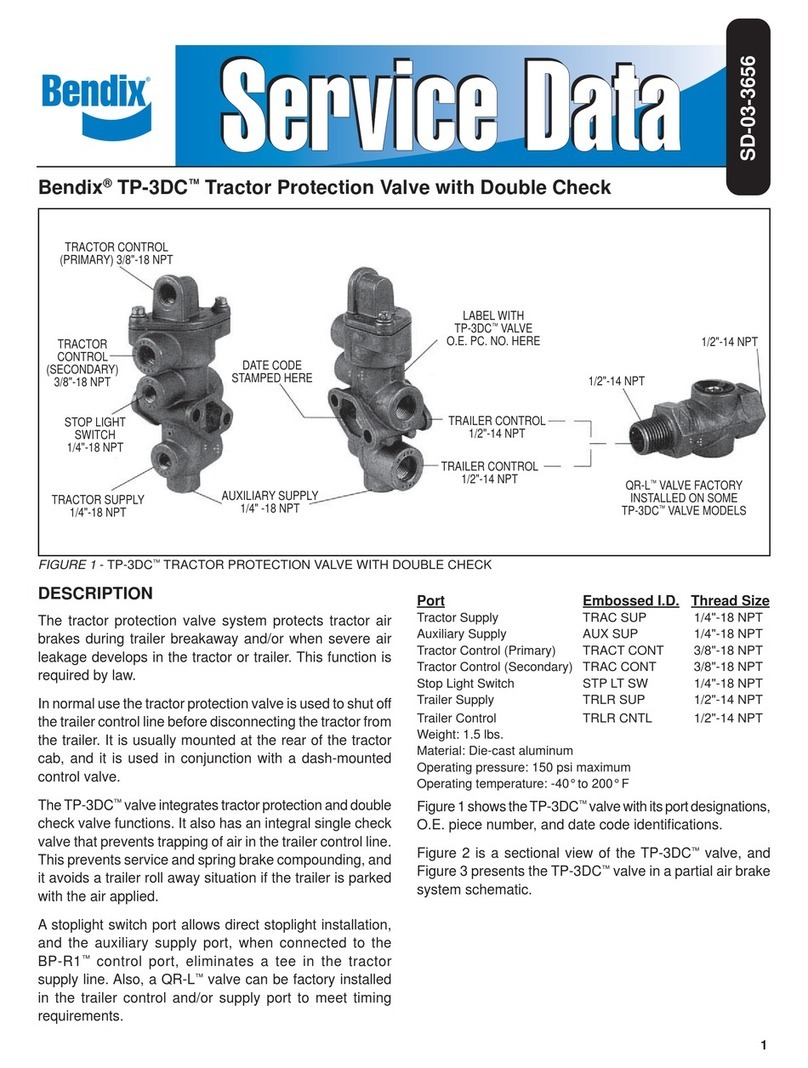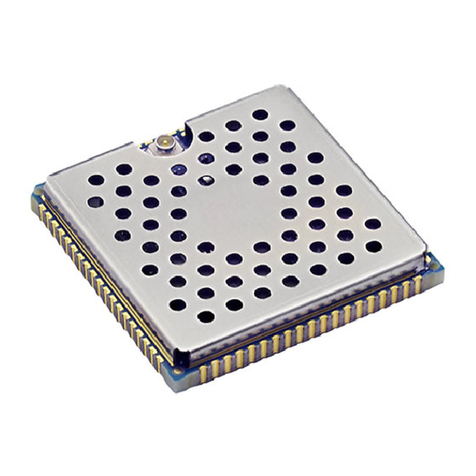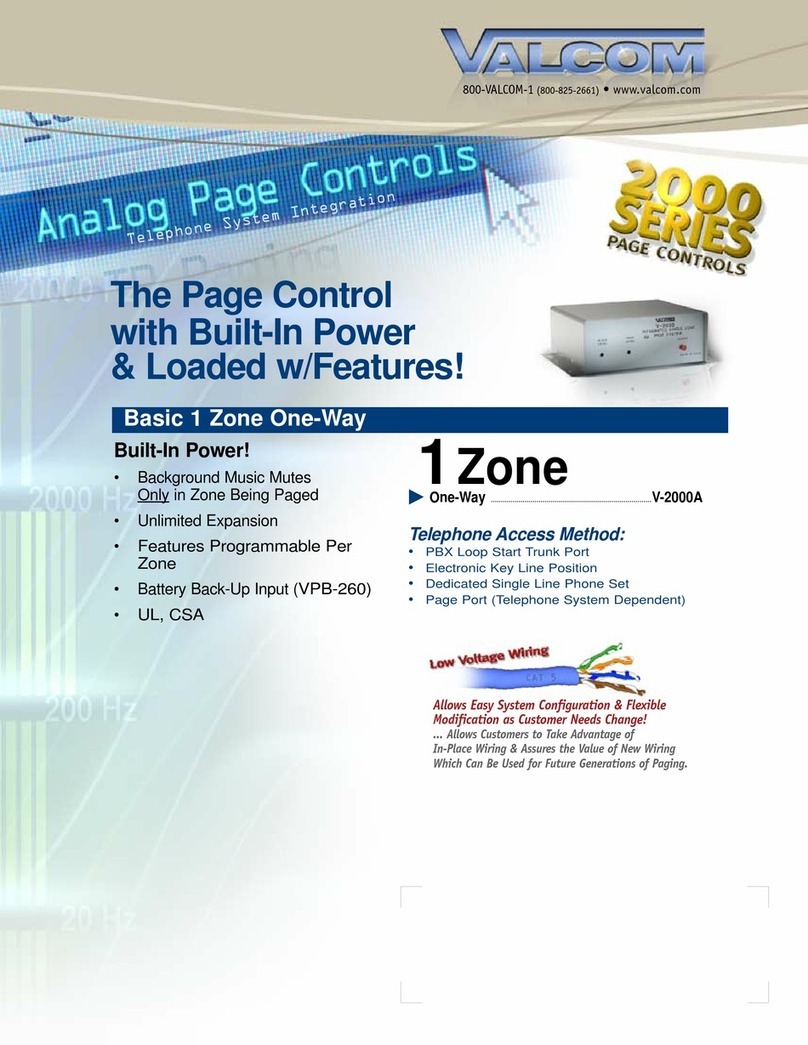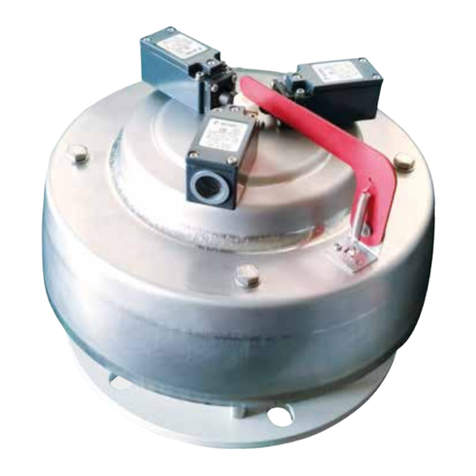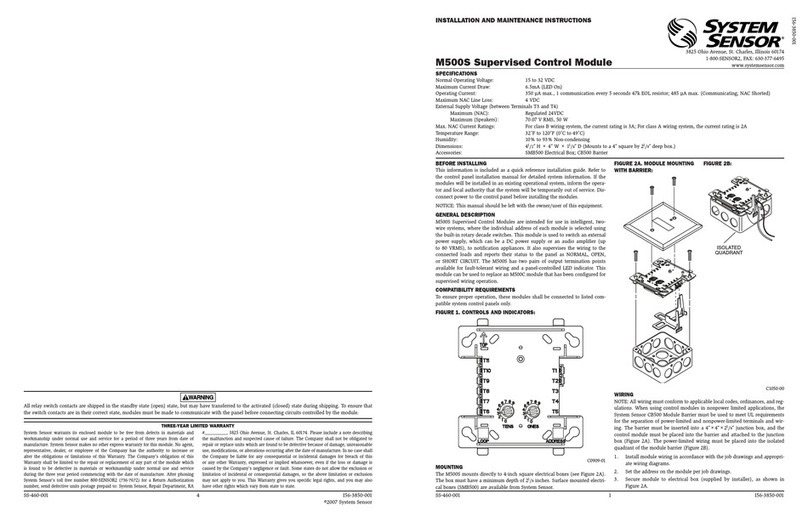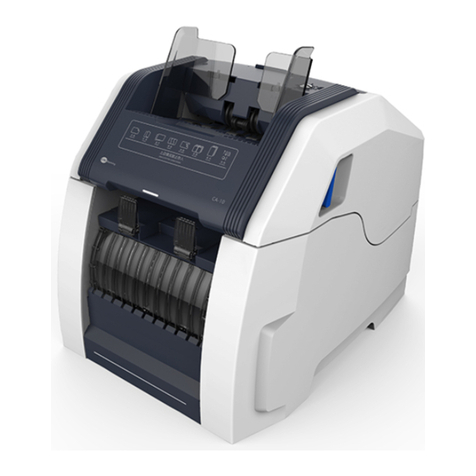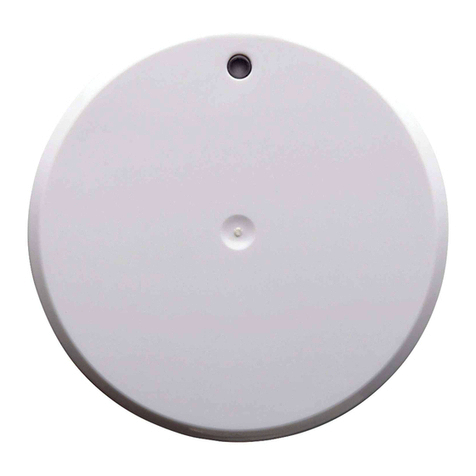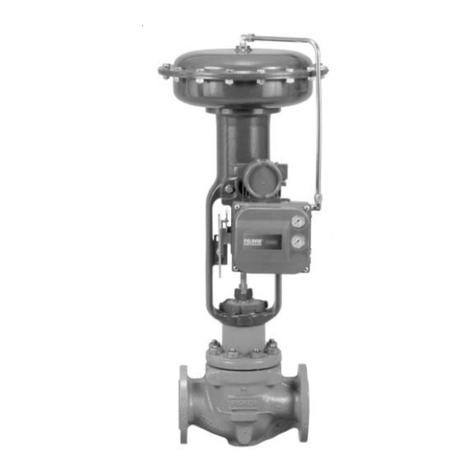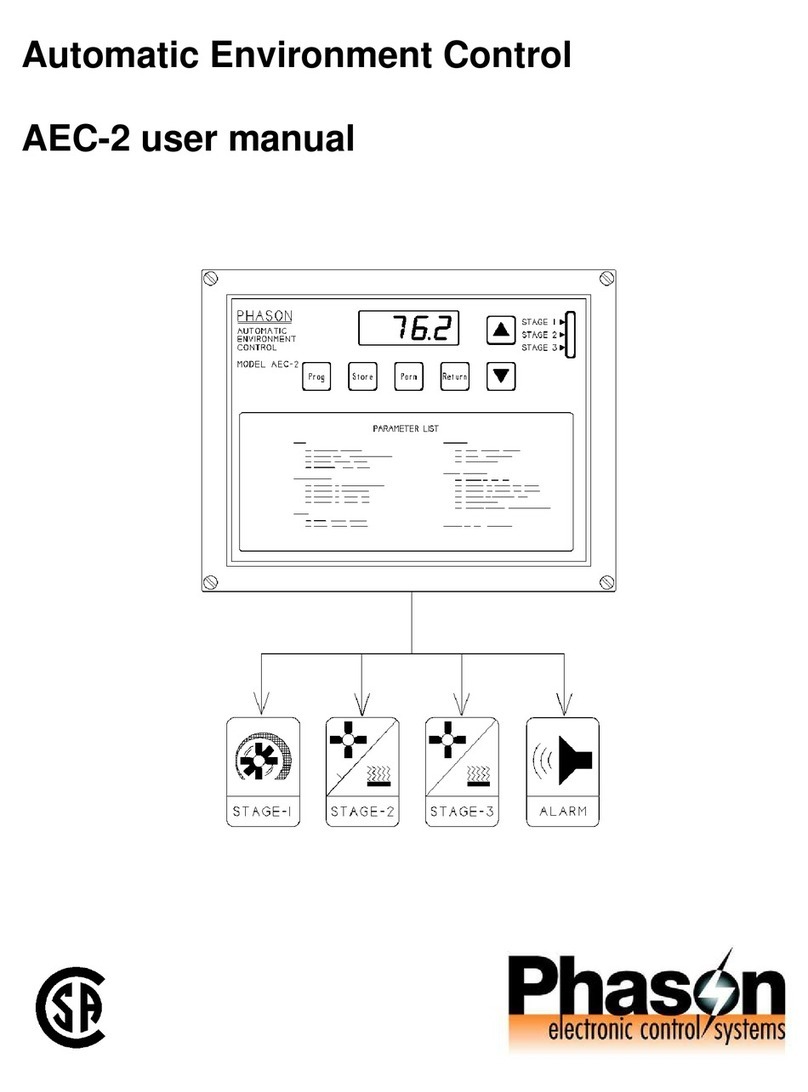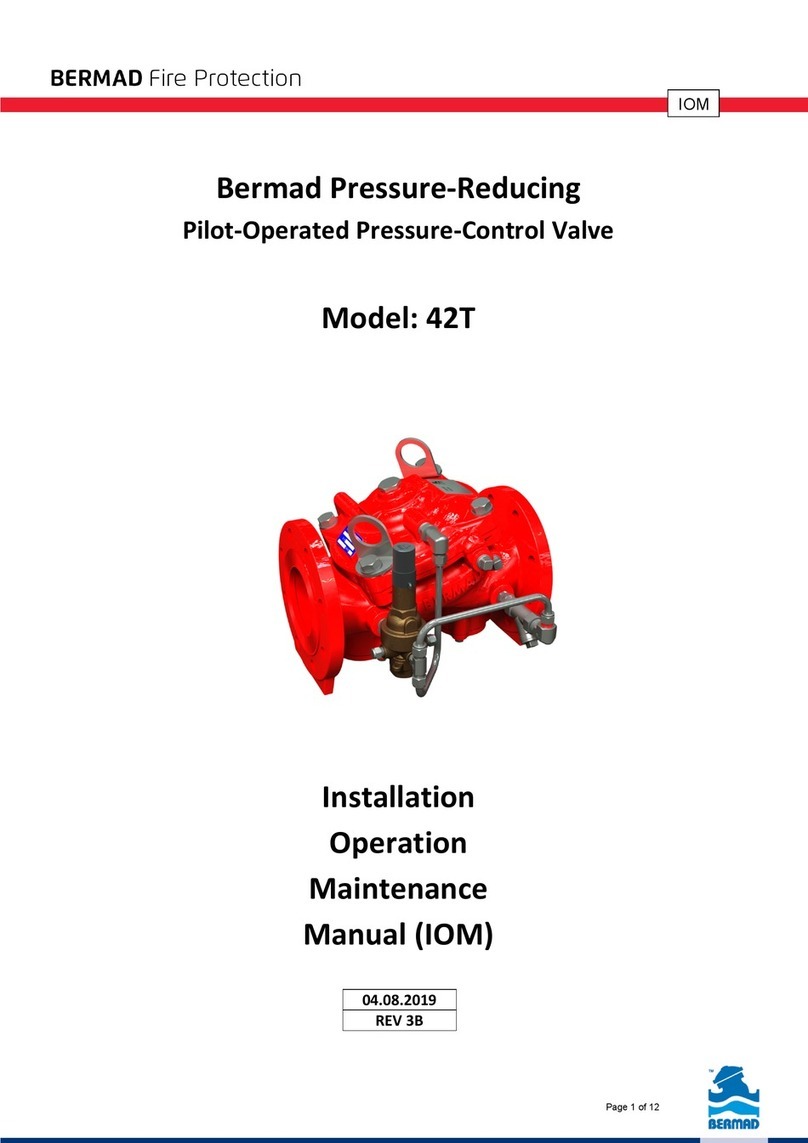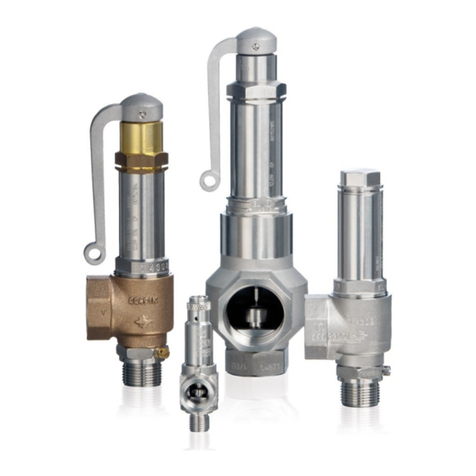Fluigent ESS User manual

USER’S
MANUAL
EASY
SWITCH
SOLUTIONS
MICROFLUIDIC VALVES

PRECAUTIONS
Place the product in an stable location with a level surface and good
support.
Do not use other power supply than the one provided with the ESSTM
The power supply provided with the ESSTM has been carefully selected
to meet the power requirements of the ESSTM in all configurations and
to comply with all safety standards.
If you are using the ESSTM platform with other flow control systems,
please check that the pressure in your fluidic system does not exceed
the maximum pressure of the valve being used.
Aria is a perfusion system which automates perfusion or timed
injection protocols. It allows for the sequential delivery of up to
10 different solutions at the desired flow rate into a microfluidic
chip, perfusion chamber or petri dish.
Do not open SWITCHBOARD, 2-SWITCHTM, M-SWITCHTM or L-SWITCHTM
devices. Please refer all service issues to our Support department
(support@fluigent.com)
Prevent any objects or liquid from entering the SWITCHBOARD. This
may cause a short-circuit or other malfunction. Failing to follow these
instructions may:
• Expose the user to direct current/voltage if the device is powered.
This may lead to damages.
• Void device's warranty
• Discharge our company from any liability regarding physical or
device damages.

INTRODUCTION 4
QUICK START GUIDE 7
2SWITCHTM VALVE 8
F 8
P 10
F 12
P 14
MSWITCHTM VALVE 15
F 15
P 17
F 19
P 21
LSWITCHTM VALVE 22
F 22
P 24
F 26
P 31
SWITCHBOARD 32
P 32
C 34
FLUIDIC CIRCUIT EXAMPLES 37
FREQUENTLY ASKED QUESTIONS 42
TECHNICAL SPECIFICATIONS 44
SERVICING & WARRANTY 46
S 46
C 46
W 47
SUMMARY

4
The Easy Switch SolutionTM platform (ESSTM) provides solutions for path
selection in microfluidics. The Easy Switch SolutionsTM platform enables
one to implement 3 different kind of valves in a microfluidic circuit.
INTRODUCTION
1. The 2-SWITCHTM is a 3-port/2-position
solenoid valve: 2 ports can alternatively be
connected to a third one.
2. The M-SWITCHTM is a 11-port/10-position
rotary valve: 10 peripherical ports connected
to a central one.
3. The L-SWITCHTM is a 6-port/2-position valve
to inject precise volume of fluid or for switching
fluid to different channels.
4. The SWITCHBOARD is a hub that hosts up to 4 M-SWITCHTM
or 4 L-SWITCHTM and up to 8 2-SWITCHTM. The device allows for
communication of the SWITCHes to a PC with Fluigent software :
ESSTM Control for live control or Microfluidic Automation Tool (MAT)
to automate protocols. It also ensures power supply to the connected
valves.
1
2
3
4

5
The ESS™ platform has been designed to work at its best
performance with FLUIGENT pressure-based flow control solutions
(LineUpTM series MFCS™ series and Flow-Rate Platform).
Combining the 2-SWITCH™, M-SWITCH™ and L-SWITCH™ valves
into one experiment, using the SWITCHBOARD allows one to access
new possibilities to easily design and build even the most complex
microfluidic circuits.
INTRODUCTION
It is possible to use the ESS™ platform with other flow control
systems provided that the pressure applied to the ESS™ devices
does not exceed the maximum pressure rating of the valves.
Note: To ensure product longevity, the M-SWITCHTM should not be
used with an operational pressure above 5 bar (~72,5 psi)
This manual explains how to use the ESS™ series for one's daily work.

6
Here is a quick set-up and quick start guide to summarize
of the main steps to get the ESS™ platform up and running.
QUICK START GUIDE
Fluidic connections on the 2-SWITCH™ , M-SWITCH™ and
L-SWITCH™ that user wants to use:
See page 13 for the 2-SWITCH™ fluidic connection how-to
See page 20 for the M-SWITCH™ fluidic connection how-to
See page 27 for the L-SWITCH™ fluidic connection how-to
1
Position the devices in the most practical configuration for the
application.
See page 14 for the different 2-SWITCH™ mounting options
See page 21 for the different M-SWITCH™ positionning options
See page 31 for the different L-SWITCH™ positionning options
2
If using a L-SWITCHTM, connect the device RJ45 port with the
provided flat RJ45 white cable.
3
Note: If one is using a 2-SWITCHTM or M-SWITCHTM, the RJ45
cables are integrated into the device. There is no need to
connect another cable to the valve.

7
Connect the SWITCHBOARD to the power supply as explained
page 37 and then connect the RJ45 cables to the dedicated
SWITCHBOARD RJ45 ports (white RJ45 cables for M-SWITCH™
and L-SWITCH™ and blue RJ45 cables for 2-SWITCH™).
QUICK START GUIDE
4
If one wishes to use Fluigent Microfluidics Automation Tool
(MAT) or the ESS™ Control software provided with the devices,
connect a USB cable from the SWITCHBOARD to the computer
where MAT or ESS™ Control is installed (see page 38)
5
After the experiment, do not forget to rinse the 2-SWITCH™,
M-SWITCH™ and L-SWITCH™ with distilled water and then
isopropanol, to avoid any clogging in the fluidic parts that could
damage the device and cause malfunction.
The ESSTM is now ready to operate either by automating a protocol
using the MAT or in live control using the ESSTM Control software.

8
The 2-SWITCH™ is a 3-port / 2-position valve. Each
of the three ports can be connected with fittings
and tubing to microfluidic set-up or other device.
The fluids can be directed bidirectionally into the
device with a maximum pressure of 2.5 bar (36 psi).
2SWITCHTM VALVE
F
The dark blue “C” port at the bottom of the diagram is the common
central port: it can be either connected to port #1 or to port #2
depending on the selected position.
F 2-
At position #1, the common cen-
tral (C) port is linked to the port #1.
The flow is bidirectional between
those two ports. A blue LED on the
device indicates this current position.
By pressing the local button or
using software, the valve will change
position from 1 to 2. A white LED
will now indicate the position #2.
1 2
C
1
2
P 1

9
2SWITCHTM
The fluidic “ON/OFF” switch configuration only works if port #1
or port #2 is plugged. If the common C port is plugged then no
flow can circulate through the 2-SWITCH™ (see bottom diagram).
Another possibility for using the 2-SWITCH™ is to plug one of the
two ports (#1 or #2). This way, one of the positions of the 2-SWITCH™)
becomes a closed position, and the 2-SWITCH™ acts as an “ON/OFF”
switch.
F ON/OFF
1 2
C
P 1 P 2
12
C

10
MAT
2SWITCHTM
P
The front of the 2-SWITCH™.
Two LED indicators on the front show the current position of the
2-SWITCH™.
A blue LED for position 1 linking the common port to port #1.
A white LED for position 2 linking the common port to port #2.
The top of the 2-SWITCH™ also includes a push button to manually
switch between position 1 and position 2.
P
The 3 fluidic ports are located at the
front face of the device. The common
port is the central one. When looking
at the front of the 2-SWITCH™, one
can see the LED indicators, 2 points
to indicate the port number 2 and
a single point to indicate the port
number 1.
1
2
3
4
5
6
1Position switch button 4Central common port
2Blue LED for position 1 5Port number 2
3Port number 1 6White LED for position 2

11
Back of the 2-SWITCH™.
C F
FLUIGENT recommends to only use the cables provided with
the ESS™.
2SWITCHTM
A RJ45 cable connects the 2-SWITCH™ to the SWITCHBOARD. Plug
the cable into a dedicated port on the SWITCHBOARD (blue cable
should be plugged in blue port).
The bottom and the top faces of the 2-SWITCH™ are complementary:
two or more 2-SWITCHes™ can be assembled together by inserting
the top face of one 2-SWITCH™ into the bottom face of another one.
A magnet holds the two 2-SWITCH™ together.

12
The 2-SWITCH™ has 3 fluidic ports, described as “Common port”,
“Port #1” and “Port #2”.
2SWITCHTM
F
Common characteristics of the 3 ports are:
• Thread-size: ¼-28
• Flat-bottom type (FB).
• Tubing compatibility: 1/16’’ external diameter (1/16’’ OD).
Fluigent provides the following contents:
12 * Flat bottom ferrules 1/16''
2* Plug Delrin® - ¼-28 Flat Bottom
6* ¼-28 connectors for 1/16’’ OD tubing
2m of FEP tubing: 1/16’’OD and 0.010’’ID
NB: There is a wide variety of materials and internal diameters available with
1/16’’ tubing from fittings suppliers to suit ones application.
P/N CTQ-KIT-2SW2
These fittings have been specifically selected by FLUIGENT
to ensure good 2-SWITCH™ operation. FLUIGENT advises you
to use only these fittings on the 2-SWITCH™. Please note that
only tubing of 1/16’’ external diameter should be used with the
2-SWITCH™. Use of other tubing sizes with or without tubing
sleeves, can damage the 2-SWITCH™ and (or) leak.

13
H
2SWITCHTM
1. Cut the 1/16’’ OD tubing to the desired
length, leaving a square-cut face.
2. Slide the ¼ -28 fitting over the tubing,
with the thread facing outwards. Slip the
ferrule over the tubing, with the tapered
portion of the ferrule facing the fitting.
3. The connectors and ferrules are
specifically designed to work together. Use
the provided ferrules and nuts together.
4. Insert the assembly into the receiving
port, and while holding the tubing firmly
against the bottom of the port, tighten
the connector.
5. To check the tightness of the
connection, you may pull gently on the
tubing and verify that it remains secure.
1
2
3
4
5

14
There are several ways to position the 2-SWITCH™.
The 2-SWITCH™ can be used in any spatial configuration.
2SWITCHTM
P
Vertically Horizontally
Stacked
On side

15
The M-SWITCH™ is an 11-port / 10-position valve. This
means that eleven (11) ports can be connected with
tubing, such that it is possible to choose between
ten (10) individual positions linking one of the ten
(10) external ports to the central port of the valve.
MSWITCHTM VALVE
F
The fluid paths of the M-SWITCH™ are shown below. In yellow is the
common port at the centre of the M-SWITCH™. The numbered ports
are the external ports. The central port can be connected to any of
the external port, from port #1 to port #10 depending on the chosen
position (respectively from position 1 to position 10).
F
Note: When the M-SWITCH™ is not powered the last actuated position
is there it will be.
12
3
4
5
6
7
8
9
10
C
12
3
4
5
6
7
8
9
10
C
Position 1 Position 4
On the left, the valve is in
position 1, the central port
is connected to the external
port #1.
On the right, the valve is in
position 4.

16
MSWITCHTM
Unused ports must be closed with plugs
(provided within the connection kit). It is possible
to use a plugged position to close a fluidic path.
The M-SWITCH™ is a bidirectional valve. The fluid can flow inside
the M-SWITCH™ in both directions. This feature plus the rotary
capabilities allow different ways of use.
B
Distributor mode: fluid flows from the central port to one external port
(according to the selected position). One has the possibility to inject
solutions into up to 10 chips or reservoirs.
Selector mode: Fluid flows from one of the external ports (according
to the selected position) to the central port. One can select and deliver
a solution from ten reservoirs sequentially.

17
MSWITCHTM
P
Photo of the M-SWITCH™.
D
The connection ports are
located on the head of the
valve. 10 external ports are
placed radially, and the
common central port is
located vertically at the center
of the head. To connect
tubing, standard flangeless
connectors are required.
2
1Rotary valve head
2RJ47 cable
3Common port
4External port (1 to 10)
1
4
3
RJ45 cable

18
The rear of the M-SWITCH™.
C F
Only use the cables provided with the ESS™ for ESS™ operation.
MSWITCHTM
An RJ45 cable connects the M-SWITCH™ to the SWITCHBOARD.
Plug the cable into dedicated port on the SWITCHBOARD (white
cable should be plugged in white port).
To the PC
Power
supply
Control

19
MSWITCHTM
F
The M-SWITCH™ has 11 fluidic ports, described as “Common port”,
and “Port #1” to “Port #10”.
The characteristics of the ports are:
• Thread-size: ¼-28
• Flat-bottom type (FB).
• Tubing compatibility: 1/16’’ external diameter (1/16’’ OD).
Fluigent provides the following contents:
20 * Flat bottom ferrules 1/16''
11 * Plug Delrin® - ¼-28 Flat Bottom
11 * ¼-28 connectors for 1/16’’ OD tubing
2.5 m of FEP tubing: 1/16’’OD (500µm ID)
NB: There is a wide variety of materials and internal diameters available
with 1/16’’ tubing from fittings suppliers to suit ones application.
P/N CTQ-KIT-ESSMSW003
We advises you to use only these fittings on the M-SWITCH™.
Only tubings of 1/16’’ external diameter should be used with the
M-SWITCH™.

20
H
MSWITCHTM
1. Cut the 1/16’’ OD tubing to the desired
length, leaving a square-cut face.
2. Slide the ¼ -28 fitting over the tubing,
with the thread facing outwards. Slip the
ferrule over the tubing, with the tapered
portion of the ferrule facing the fitting.
3. Only use the provided ferrules together
with the provided nuts.
4. Insert the assembly into the receiving
port, and while holding the tubing firmly
against the bottom of the port, tighten
the connector.
5. To check the tightness of your connec-
tion, you may pull gently on the tubing
and verify that it remains secure.
1
2
3
4
5
Other manuals for ESS
1
Table of contents
Other Fluigent Control Unit manuals
